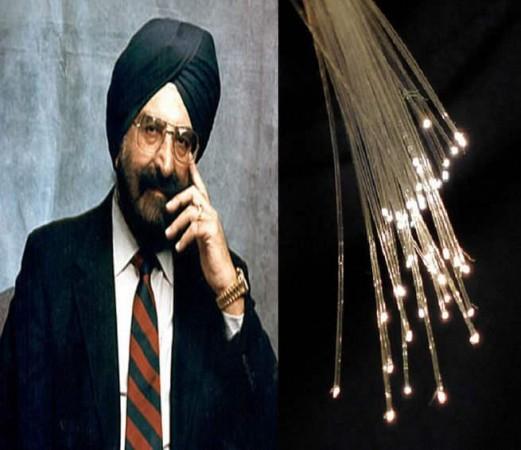If you use high-speed internet, which allows unfathomable volumes of text, image and video data to be transmitted around the globe in an instant, then this is the man who made it possible.
Charles Kuen Kao, a Shanghai-born scientist, may have received the 2009 Nobel Prize in Physics for his trailblazing work that led to a breakthrough in fibre optics, carefully calculating how to transmit light over long distances via optical glass fibres, but it was Narinder Singh Kapany, who nearly 12 years ago, had demonstrated for the first time the transmission of images over a bundle of optic fibres.

Jagdish Chandra Bose, Satyendranath Bose, CV Raman, Homi Bhabha, Janaki Ammal, Meghnad Saha, and GN Ramachandran are among the many Indian luminaries who have played their role in spreading the gospel of modern science but haven't received due credit.





But how many of us are actually aware of Kapany, who is considered by many as the "Father of Fibre Optics"? It's safe to say not many.
However, it was his path-breaking research in the 1950s on fibre optics, which paved the way for high-speed broadband internet, laser surgeries and endoscopy, among others.
The Unsung Hero
Born in 1927 to a Sikh family in Moga, Punjab, Kapany studied at Agra University. He first started working in technology at an ordnance factory learning how to design and manufacture optical instruments. He enrolled in the Imperial College in London in 1952 primarily to learn further about technology.
In a 2003 book titled "Sand to Silicon: The Amazing Story of Digital Technology," author Shivanand Kanavi detailed the contribution of Kao and Kapany in the field of fibre optics. Speaking to the author, Kapany talks about how he got interested in the field of optics.

It was during his PhD at the Imperial College in 1954 when he first managed to transmit images over a bundle of optic fibres.
In 1960, he founded Optics Technology Incorporation and served as Chairman of the board, President and Director of research for 12 years. In 1967, the company went public with numerous corporate acquisitions and joint ventures in the United States and abroad. In 1973, Kapany founded Kaptron Incorporation and was its President and CEO until 1990, when he sold the company to AMP Inc.
As an academician, Kapany had supervised research activity of postgraduate students. He was Regents Professor at the University of California, Berkeley and at the University of California. At Stanford University, he has been a Visiting Scholar in the Physics Department and Consulting Professor in the Department of Electrical Engineering. As an author and lecturer, Kapany had also published over 100 scientific papers and four books on optoelectronics and entrepreneurship.
The Multitasker
Kapany was one of those few persons who can look beyond one's self. After establishing his credentials in the world of science, he returned to his roots. He realised that the potential of Sikh art has remained unexplored. In 1967 he founded the Sikh Foundation to pursue this cause.
The Foundation also undertook a pioneering project of Sikh architectural preservation. In collaboration with UNESCO, the Foundation has restored "Guru-Ki-Maseet", a Muslim mosque built by Guru Hargobind in Sri Hargobindpur in Gurdaspur.

When the Nobel Committee awarded the 2009 Prize to Kao, many in the scientific community were perplexed that Kapany was overlooked for the award. In fact, the Nobel Committee had even acknowledged Kapany's work in a detailed publication.
Despite Kapany's work, the loss of signal over long distances via optical glass fibre was a recurring problem. What Kao did was work out how to fix this problem, and calculate how to transmit light over long distances. It was Kapany's work which led to the fabrication of the first ultrapure fibre in 1970. This was a game-changer in modern communication systems.
Being named as one of the seven "Unsung Heroes" by Fortune in their 'Businessmen of the Century' issue of November 22, 1999, Kapany passed away on December 4 at the age of 94.





!['Lip lock, pressure, pyaar': Vidya Balan- Pratik Gandhi shine in non-judgmental infidelity romcom Do Aur Do Pyaar [ Review]](https://data1.ibtimes.co.in/en/full/797104/lip-lock-pressure-pyaar-vidya-balan-pratik-gandhi-shine-non-judgmental-infidelity-romcom.jpg?w=220&h=138)







